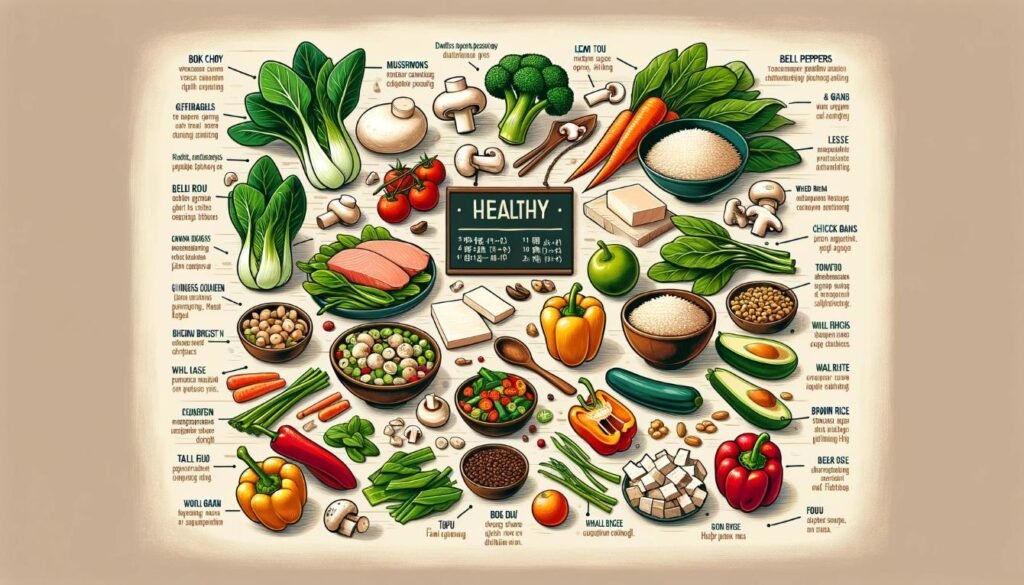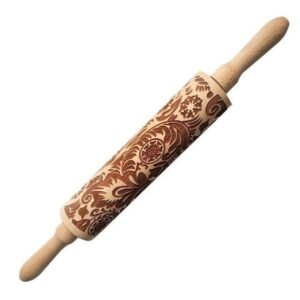Introduction

Chinese dishes often feature an array of fresh ingredients such as vegetables, lean proteins like chicken or tofu, and aromatic spices that add depth to the flavors. Soups are a popular choice in Chinese meals, providing a light and nourishing start to any meal. Chinese cuisine emphasizes the importance of balance and moderation in serving sizes.
It’s important to note that not all Chinese dishes are created equal. Some may be higher in sodium or contain added MSG (monosodium glutamate). However, by understanding how to make informed choices and incorporating simple tips into your dining experience, you can enjoy delicious Chinese food while maintaining a healthy lifestyle.
Traditional Chinese Diets: A Template for Healthy Eating Habits
In traditional Chinese diets, balance and moderation are key principles. This approach emphasizes the importance of nourishing the body with a variety of nutrients while maintaining a healthy lifestyle. Let’s delve into the components that make up a traditional Chinese diet and how they contribute to overall health.

Emphasis on Vegetables, Whole Grains, and Lean Proteins
A staple feature of traditional Chinese diets is the abundant consumption of vegetables. These colorful and nutrient-rich foods form a significant portion of each meal, providing essential vitamins, minerals, and fiber. From leafy greens like bok choy and spinach to cruciferous vegetables such as broccoli and cabbage, these veggies offer a wide array of health benefits.
Whole grains also play a crucial role in traditional Chinese diets. Foods like rice (especially brown rice), millet, oats, and barley are commonly consumed as sources of carbohydrates. Unlike refined grains found in processed foods, whole grains retain their natural fiber content and provide sustained energy throughout the day.
Lean proteins are another important component in traditional Chinese meals. Fish, poultry (such as chicken or duck), tofu, tempeh, and legumes are popular protein sources that feature prominently in this diet. These lean protein options offer essential amino acids necessary for building muscle tissue while being lower in saturated fats compared to red meats.
The Power of Herbs and Spices
Traditional Chinese cuisine is renowned for its use of herbs and spices not only for flavor but also for potential health benefits. Ingredients like ginger, garlic, turmeric, cinnamon, star anise, and Sichuan peppercorns add depth to dishes while potentially aiding digestion or boosting immune health.
For instance:
• Ginger has been traditionally used to alleviate nausea.
• Garlic is believed to have antimicrobial properties.
• Turmeric contains curcumin which exhibits anti-inflammatory effects.
• Cinnamon may help regulate blood sugar levels.
Including these herbs and spices in meals not only enhances the taste but also adds a nutritional boost to the overall diet.
Healthiest Chinese Food Options & Key Ingredients to Use
If you’re wondering whether Chinese food can be healthy, the answer is a resounding yes! By making smart choices and incorporating key ingredients, you can enjoy delicious and nutritious Chinese cuisine. Here are some tips for finding the healthiest options:

Opt for steamed or stir-fried dishes instead of deep-fried ones to reduce oil consumption.
Deep-fried dishes may be tempting, but they tend to be high in fat content. Instead, opt for steamed or stir-fried dishes that use minimal oil. Steaming preserves the natural flavors and nutrients of the ingredients without adding excessive calories. Stir-frying allows for quick cooking while still retaining the crunchiness of vegetables and proteins.
Incorporate plenty of fresh vegetables like bok choy, broccoli, and snow peas into your meals.
Fresh vegetables are an essential component of a healthy Chinese meal. They provide fiber, vitamins, and minerals while adding vibrant colors and textures to your plate. Bok choy, broccoli, snow peas, and other leafy greens are commonly used in Chinese cuisine. These veggies not only enhance the nutritional value but also contribute to a satisfying meal experience.
Choose lean protein sources such as tofu, fish, or chicken breast over fatty meats.
Protein is crucial for building and repairing tissues in our bodies. When ordering Chinese food, consider opting for lean protein sources like tofu (made from soybeans), fish (such as salmon or cod), or skinless chicken breast. These options are lower in saturated fats compared to fatty meats like pork belly or duck.
Utilize key ingredients like soy sauce, sesame oil, bone broth, and chili peppers wisely.
Soy sauce adds flavor to many Chinese dishes but should be used in moderation due to its sodium content. Opt for reduced-sodium versions if available. Sesame oil provides a rich nutty flavor and can be used sparingly as a finishing touch. Bone broth, made from simmering bones and connective tissues, is a nutritious base for soups and stews. Chili peppers not only add heat but also contain capsaicin, which may have metabolism-boosting properties.
By incorporating these key ingredients wisely, you can enhance the taste of your dishes while keeping them healthy.
Remember that portion control plays a vital role in maintaining a balanced diet. Be mindful of the quantity of food you consume and listen to your body’s hunger cues. Consider making homemade Chinese dishes using fresh ingredients whenever possible. This way, you have more control over the cooking methods and ingredients used.
Now that you know how to make healthier choices when ordering Chinese food, go ahead and enjoy this flavorful cuisine guilt-free!
Healthiest Chinese Food Dishes, According to Dietitians
If you’re a fan of Chinese cuisine but also want to make healthy choices, you’re in luck! There are several dishes that can satisfy your cravings while still being nutritious. Let’s explore some of the healthiest Chinese food options recommended by dietitians.

Mapo Tofu
Mapo tofu is a flavorful dish made with tofu and minced meat cooked in a spicy sauce. Despite its rich taste, it can be a healthy choice as it contains protein from tofu and essential nutrients from the spices used. Just be mindful of the sodium content if you have high blood pressure.
Steamed Fish
For a light yet satisfying option packed with omega-3 fatty acids, steamed fish is an excellent choice. It retains its natural flavors while being low in calories and fat. Opt for white fish such as cod or sole for a lean protein source.
Moo Shu Vegetables
Moo shu vegetables is a stir-fry dish loaded with colorful veggies wrapped in thin pancakes. This dish offers an abundance of vitamins, minerals, and fiber from the variety of vegetables used. It’s a great way to incorporate more plant-based foods into your diet.
Spring Rolls
Spring rolls are often enjoyed as an appetizer in Chinese cuisine. These crispy rolls are typically filled with vegetables and sometimes seafood or lean meats like chicken or shrimp. They can be a healthier alternative to fried options like egg rolls since they are usually not deep-fried.
Fried Rice (with Healthy Additions)
Fried rice is undeniably delicious, but it can be high in calories and unhealthy fats if prepared traditionally with excessive oil and added sodium. However, you can make it healthier by adding plenty of vegetables like carrots, peas, and bell peppers along with lean proteins such as chicken or shrimp.
Baked Salmon
While not exclusive to Chinese cuisine, baked salmon is a nutritious option often found in Chinese restaurants. It’s rich in heart-healthy omega-3 fatty acids and provides a good source of protein. Baking the salmon helps retain its natural flavors without adding excessive oil or unhealthy ingredients.
Steamed Dumplings
Steamed dumplings are a popular choice among dim sum lovers. They are typically filled with minced meat and vegetables, making them a balanced option. Steaming the dumplings instead of frying them reduces the amount of added fat.
Hot and Sour Soup
Hot and sour soup is a flavorful broth-based soup that combines spicy and tangy flavors. It often contains ingredients like tofu, mushrooms, bamboo shoots, and eggs. This soup can be low in calories while still providing plenty of flavor.
Stir-Fried Vegetables
Stir-fried vegetables are a staple in Chinese cuisine and offer an array of health benefits. The quick cooking method helps to retain nutrients, while the variety of vegetables used ensures you get a range of vitamins, minerals, and fiber.
Kung Pao Chicken (with Modifications)
Kung Pao chicken is known for its bold flavors from the combination of chili peppers, peanuts, and soy sauce.
Worst Chinese Food Options to Avoid
If you’re trying to make healthier choicesThere are certain dishes you should steer clear of. While Chinese cuisine can offer a variety of nutritious options, some dishes tend to be less healthy due to their high calorie, sodium, and fat content. Let’s take a closer look at the worst Chinese food options that you should avoid.
Sweet and Sour Chicken
Sweet and sour chicken is a popular dish in many Chinese restaurants. However, this seemingly innocent dish can pack a punch. The chicken is typically deep-fried, which adds unnecessary fat and calories. The sweet and sour sauce often contains high amounts of added sugar. So while it may taste deliciously tangy, it’s not the healthiest choice on the menu.
General Tso’s Chicken
Another dish that falls into the unhealthy category is General Tso’s chicken. This deep-fried chicken dish is known for its crispy exterior and rich sauce. Unfortunately, it also tends to be loaded with sodium. Excessive sodium intake can contribute to high blood pressure and other health issues. So if you’re looking for a healthier option, it’s best to skip this one.
Crab Rangoon
Crab rangoon is a tempting appetizer found in many Chinese-American restaurants. These fried dumplings are filled with cream cheese and sometimes imitation crab meat. While they may be tasty bites, they lack nutritional value. The combination of deep-frying and cream cheese filling makes them high in fat and calories without offering much in terms of essential nutrients.
When dining out or ordering takeout from your favorite Chinese restaurant, keep these worst options in mind so that you can make more informed choices about what you eat.
Remember that moderation is key even when indulging in these less healthy dishes—enjoying them occasionally won’t derail your overall efforts to maintain a balanced diet. If you’re looking for healthier alternatives, consider dishes that are steamed or stir-fried with lean protein and plenty of vegetables. Opt for sauces that are lighter and less sugary, such as garlic sauce or oyster sauce.
By being mindful of your choices and paying attention to the ingredients used in various Chinese dishes, you can still enjoy the flavors and experience of Chinese cuisine while making healthier decisions.
Healthy Swaps and Additions for Chinese Food
If you’re wondering whether Chinese food can be healthy, the answer is yes! While some Chinese dishes may not always be the healthiest choice, there are plenty of ways to make healthier swaps and additions to your favorite Chinese dishes. Let’s explore some options that will help you enjoy a nutritious and satisfying meal.
Swap white rice for brown rice or cauliflower rice
Instead of opting for white rice, which is more processed and lower in fiber, consider swapping it out for brown rice or cauliflower rice. Brown rice retains its outer bran layer, making it higher in fiber and nutrients. It provides a nutty flavor and chewier texture that pairs well with many Chinese dishes. If you’re looking to cut down on carbs or add more veggies to your meal, cauliflower rice is an excellent alternative. It’s made by finely chopping cauliflower into small pieces that resemble grains of rice. Both options offer more fiber, vitamins, and minerals compared to traditional white rice.
Use low-sodium soy sauce or tamari
Soy sauce is a staple ingredient in many Chinese dishes but can be high in sodium content. To reduce your sodium intake without compromising flavor, opt for low-sodium soy sauce or tamari instead. These alternatives contain less salt while still providing the savory taste you love. You can find them at most grocery stores or Asian markets.
Add extra vegetables to your dishes
One way to boost the nutritional value of your Chinese food is by adding extra vegetables to your dishes. Many traditional Chinese recipes already include a variety of veggies like broccoli, carrots, green onions, cabbage, ginger, water chestnuts, bamboo shoots, garlic, and scallions. However, if you feel like there could be more veggies in your dish or want to customize it further according to your preferences, don’t hesitate to ask for additional vegetables when ordering takeout or prepare them at home. Steamed vegetables are a great option as they retain most of their nutrients and add color and crunch to your meal.
Choose steamed or stir-fried dishes
Steaming or stir-frying is generally healthier than deep-frying. Steamed dishes help preserve the natural flavors and nutrients of the ingredients without adding excess oil or fat. Stir-frying involves quickly cooking ingredients in a small amount of oil over high heat, which retains their texture and flavor while using less oil compared to deep-frying. Opting for steamed or stir-fried options can help you enjoy Chinese food while keeping it light and nutritious.
By making these simple swaps and additions, you can transform your Chinese food into a healthier and more wholesome meal. Remember, moderation is key when enjoying any type of cuisine, including Chinese food. It’s all about finding the right balance between indulgence and nourishment.
Drinks and Desserts in Chinese Cuisine
In addition to the main courses, Chinese cuisine also offers a variety of drinks and desserts that can be enjoyed alongside your meal. Let’s take a closer look at some popular options:
Traditional Chinese Tea
Traditional Chinese tea, such as green tea or oolong tea, is not only a cultural staple but also a healthy beverage choice. These teas are rich in antioxidants and have been associated with various health benefits. They can aid digestion, boost metabolism, and even help with weight management. So next time you visit a Chinese restaurant, consider ordering a pot of hot green tea to complement your meal.
Fresh Fruit Platters and Fruit-Based Desserts
If you’re looking for lighter optionsFresh fruit platters or fruit-based desserts are great choices. Instead of indulging in deep-fried sweets or sugary treats, opt for a refreshing plate of sliced fruits like watermelon, pineapple, or mango. Not only are they deliciously sweet, but they also provide essential vitamins and minerals.
Sugary Drinks to Avoid
While there are healthier drink options available in Chinese cuisine, it’s important to be mindful of certain beverages that may contain high amounts of sugar. Bubble tea and sweetened fruit juices are examples of drinks that can be high in calories due to added sugars. These sugary drinks should be consumed in moderation as part of an overall balanced diet.
When enjoying Chinese cuisine, it’s crucial to pay attention to the sauces used as they can significantly impact the nutritional value of your meal:
Oyster Sauce and Other Condiments
Oyster sauce is commonly used in many Chinese dishes for its savory flavor. However, it’s essential to consume it in moderation as it contains higher sodium content compared to other condiments. The same goes for other sauces like soy sauce or hoisin sauce – use them sparingly as they can add extra salt and calories to your meal.
Soup Selections
Chinese cuisine offers a variety of soups, some of which can be healthier choices than others. Sour soup and egg drop soup are examples of lighter options that are often packed with vegetables and lean proteins. These soups can provide essential nutrients while being relatively low in calories. However, it’s important to be cautious about cream-based soups or those with added fats, as they can be higher in calories and saturated fats.
Conclusion
Chinese food can be a healthy option if you make the right choices. Traditional Chinese diets, with their emphasis on vegetables, whole grains, and lean proteins, provide a template for healthy eating habits. By choosing the healthiest options and key ingredients, such as steamed dishes, stir-fried vegetables, and lean meats, you can enjoy the flavors of Chinese cuisine while nourishing your body.
Remember to avoid the worst Chinese food options, which are often deep-fried or high in sodium. Instead, opt for healthy swaps and additions like brown rice instead of white rice or adding extra vegetables to your dishes. Don’t forget about drinks and desserts in Chinese cuisine; choose herbal teas or fresh fruit for a healthier alternative.
So next time you’re craving Chinese food, remember that making informed choices can lead to a delicious and nutritious meal. Explore the diverse world of Chinese cuisine and enjoy the benefits of a balanced diet. Your taste buds and your body will thank you!
FAQs
Is Chinese food healthy?
Chinese food can be healthy if you make wise choices. Opt for steamed or stir-fried dishes instead of fried ones. Choose lean proteins like chicken, shrimp, or tofu and load up on vegetables. Be mindful of sauces that may contain high amounts of sodium or sugar.
Can I eat Chinese food while on a diet?
Yes, you can enjoy Chinese food while on a diet. Stick to dishes that are steamed, grilled, or stir-fried with minimal oil. Skip the deep-fried options and choose lean proteins like chicken or fish along with plenty of vegetables. Control your portion sizes and be conscious of added sauces and condiments.
Are all Chinese dishes high in calories?
Not all Chinese dishes are high in calories. Some healthier options include steamed dumplings, hot and sour soup, and stir-fried vegetables with lean protein. However, certain dishes like sweet and sour pork or General Tso’s chicken tend to be higher in calories due to their frying methods and sugary sauces.
How can I make healthier choices when ordering Chinese takeout?
To make healthier choices when ordering Chinese takeout, opt for steamed or lightly sautéed dishes instead of deep-fried ones. Look for items labeled as “steamed,” “grilled,” or “broiled.” Choose vegetable-based dishes with lean proteins and request sauce on the side to control the amount you consume.
What are some common healthy options in a typical Chinese menu?
Common healthy options in a typical Chinese menu include steamed dumplings, vegetable spring rolls, hot and sour soup, Buddha’s delight (mixed vegetables), moo goo gai pan (chicken with mushrooms), kung pao shrimp (spicy shrimp with peanuts), and broccoli beef (stir-fried beef with broccoli). These dishes offer balanced nutrition without excessive calories.
Frequently Linked Pages
1. Hot and Sour Soup Recipe – Hot And Sour Soup Recipe: Restaurant-Style Authenticity!
2. Best Chinese Food Near Me – Best Chinese Food Near Me: Exploring Authentic Flavors Around The Corner
3. Chinese Food Menu – Chinese Food Menu: Delightful Selections To Satisfy Every Palate







